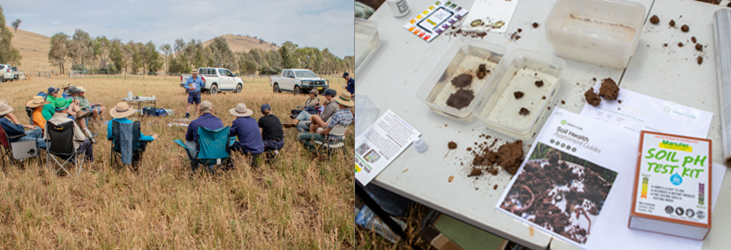Paddock, Farm, Landscape - building our communities natural capital from the soil up
With funding from the Australian Government's Future Drought Fund, 15 landholders in the Riverina region were chosen to establish demonstration sites on their properties. These sites showcased drought-resilient practices across a variety of landscapes, from the rangelands in the west to the highlands in the east.
The demonstration sites showcased three drought-resilient practices that are known to enhance productivity and profitability during and after droughts. These practices included managing grazing pressure by using Stock Management Areas (SMAs), improving farm dams by limiting livestock access and carrying out revegetation, and establishing native shelterbelts to mitigate the effects of wind exposure across pastures, crops and livestock.

With the support of key partners, Soils for Life and the Australian National University, landholders engaged in online peer-to-peer learning activities with topics including:
- how to make regular, low-cost on-farm soil observations
- design and use of SMA’s in dry times, and livestock feeding and health considerations in confinement feeding
- grazing management strategies to maintain groundcover
- improving natural assets to build farm biodiversity and soil health.
Participants took part in hands-on soil testing in collaboration with Soils for Life soil scientists and extension staff. Soil samples were analyzed in a laboratory, and comprehensive soil reports were provided to landholders. One-on-one sessions were held to explain the detailed results and translate them into actionable farm management strategies for the present and future. In addition to simple on-farm observation techniques, project participants now have the skills to make informed management decisions based on a deeper understanding of soil health.

The project is utilising the latest research from the ANU Sustainable Farms program to highlight how these drought resilient practices are a win‐win for both biodiversity and productivity. These practices have been shown to increase the capacity for carbon storage, provide protection against heat and cold as well as increase water infiltration, making them a valuable resource during dry times.
In combination with ANU Sustainable farms, field days were held across the Riverina LLS region, with field ecologists providing valuable discussions on natural assets including Farm Dams and water quality, Shelterbelts, paddock trees and related biodiversity.
Case Studies
The Wilkes-Bowes at Anderloose
Jack and Annabel Hanna at Erin
The Matthews at Bedarbidgal
The Scotts at Glen Elgin
The Nicholls at Tumulla
Riverina Drought Resilient Soils and Landscape Project
The Riverina Drought Resilient Soils and Landscapes Project
Soil Monitoring
Native Shelterbelts
Resources
- Soil health assessment guide
Please note: the guide was refined for Soils for Life's Soil Health Challenge and continues to be developed. For the most updated version visit www.soilsforlife.org.au - Detailed Case studies
- Soil Resources
Contact
For further information on this project, please contact Project Officer, Ben Muller email ben.muller@lls.nsw.gov.au or 0474 701 289.